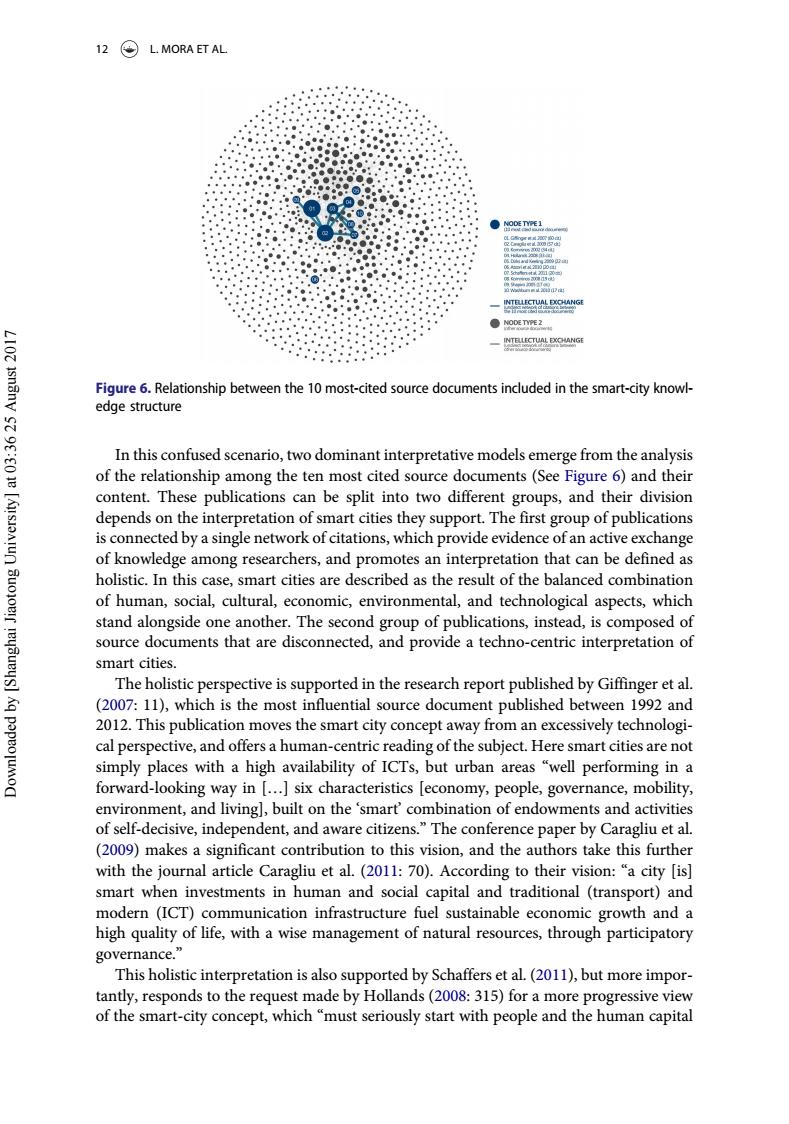正在加载图片...

12©L.MORA ET AL. ●O0TE1 INTELECTUAL XOANGE ●No0EDE2 INTELLECTUAL XOANGE LIOZ 1sn3nV s 9:EO Figure 6.Relationship between the 10 most-cited source documents included in the smart-city knowl- edge structure In this confused scenario,two dominant interpretative models emerge from the analysis of the relationship among the ten most cited source documents(See Figure 6)and their content.These publications can be split into two different groups,and their division depends on the interpretation of smart cities they support.The first group of publications is connected by a single network of citations,which provide evidence of an active exchange of knowledge among researchers,and promotes an interpretation that can be defined as holistic.In this case,smart cities are described as the result of the balanced combination uojoe!f eyueys] of human,social,cultural,economic,environmental,and technological aspects,which stand alongside one another.The second group of publications,instead,is composed of source documents that are disconnected,and provide a techno-centric interpretation of smart cities. The holistic perspective is supported in the research report published by Giffinger et al. (2007:11),which is the most influential source document published between 1992 and 花o P 2012.This publication moves the smart city concept away from an excessively technologi- cal perspective,and offers a human-centric reading of the subject.Here smart cities are not simply places with a high availability of ICTs,but urban areas "well performing in a forward-looking way in [...six characteristics [economy,people,governance,mobility, environment,and living],built on the 'smart'combination of endowments and activities of self-decisive,independent,and aware citizens."The conference paper by Caragliu et al. (2009)makes a significant contribution to this vision,and the authors take this further with the journal article Caragliu et al.(2011:70).According to their vision:"a city [is] smart when investments in human and social capital and traditional(transport)and modern (ICT)communication infrastructure fuel sustainable economic growth and a high quality of life,with a wise management of natural resources,through participatory governance." This holistic interpretation is also supported by Schaffers et al.(2011),but more impor- tantly,responds to the request made by Hollands(2008:315)for a more progressive view of the smart-city concept,which "must seriously start with people and the human capitalIn this confused scenario, two dominant interpretative models emerge from the analysis of the relationship among the ten most cited source documents (See Figure 6) and their content. These publications can be split into two different groups, and their division depends on the interpretation of smart cities they support. The first group of publications is connected by a single network of citations, which provide evidence of an active exchange of knowledge among researchers, and promotes an interpretation that can be defined as holistic. In this case, smart cities are described as the result of the balanced combination of human, social, cultural, economic, environmental, and technological aspects, which stand alongside one another. The second group of publications, instead, is composed of source documents that are disconnected, and provide a techno-centric interpretation of smart cities. The holistic perspective is supported in the research report published by Giffinger et al. (2007: 11), which is the most influential source document published between 1992 and 2012. This publication moves the smart city concept away from an excessively technological perspective, and offers a human-centric reading of the subject. Here smart cities are not simply places with a high availability of ICTs, but urban areas “well performing in a forward-looking way in […] six characteristics [economy, people, governance, mobility, environment, and living], built on the ‘smart’ combination of endowments and activities of self-decisive, independent, and aware citizens.” The conference paper by Caragliu et al. (2009) makes a significant contribution to this vision, and the authors take this further with the journal article Caragliu et al. (2011: 70). According to their vision: “a city [is] smart when investments in human and social capital and traditional (transport) and modern (ICT) communication infrastructure fuel sustainable economic growth and a high quality of life, with a wise management of natural resources, through participatory governance.” This holistic interpretation is also supported by Schaffers et al. (2011), but more importantly, responds to the request made by Hollands (2008: 315) for a more progressive view of the smart-city concept, which “must seriously start with people and the human capital Figure 6. Relationship between the 10 most-cited source documents included in the smart-city knowledge structure 12 L. MORA ET AL. Downloaded by [Shanghai Jiaotong University] at 03:36 25 August 2017